1. Proxy for Risk…See If Softbank Breaks to New Lows
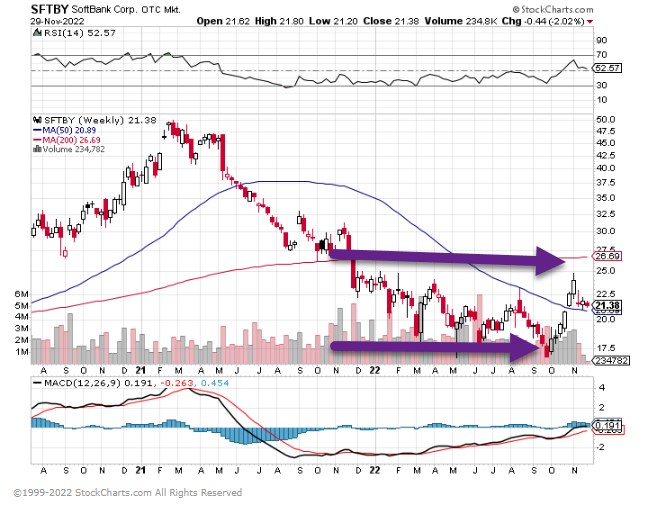
2. Bear Market?…Nasdaq NDAQ Approaching New Highs
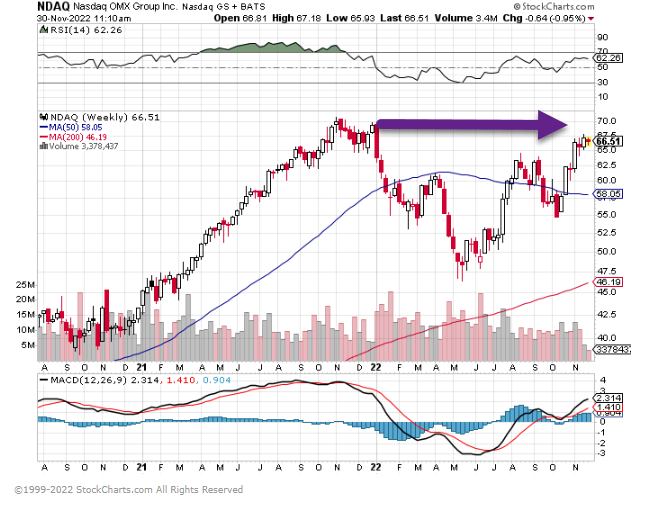
3. Video Game Sales First Down Revenue Year in a Decade
NERD ETF $40 to $14
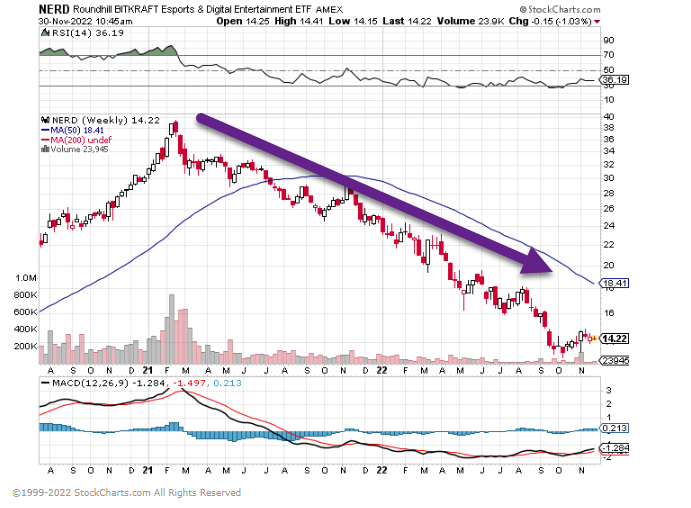
HERO ETF Global X Video Games and Esports $26 to $18
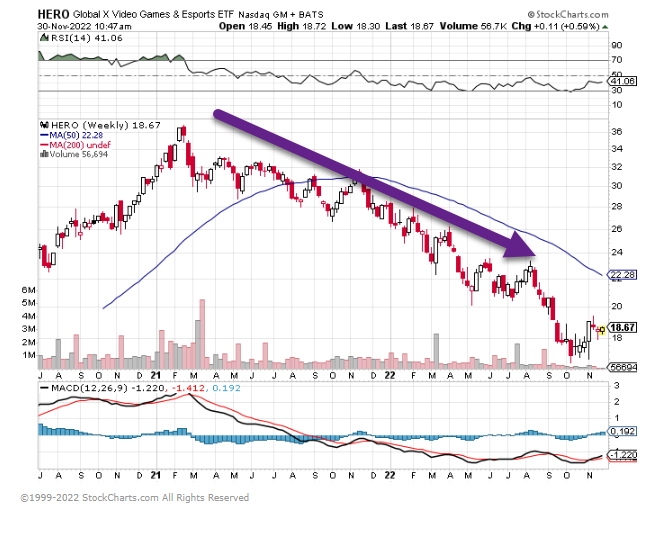
4. Vanguard Developed International ex-U.S. Closes Above 200day Moving Average
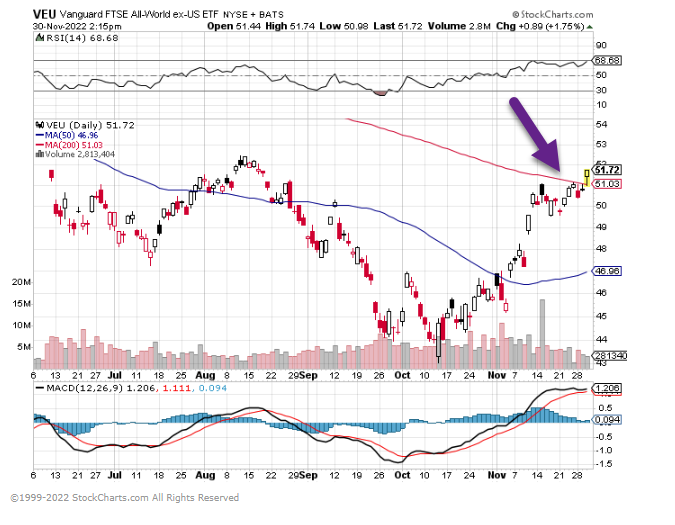
5. Tesla Price to Sales 23x to 8x
Macro Trends-Tesla price to sales chart.

https://www.macrotrends.net/stocks/charts/TSLA/tesla/price-sales
6. Tech Jobs on Ziprecruiter Went Up 87% in One Year…..Now Falling
Marketwatch Zoe Han
The number of job postings for jobs in the technology sector on ZipRecruiter peaked in May with more than 1.9 million jobs, up 87% from February 2020 just before the coronavirus outbreak was declared a pandemic. But hiring started declining in June around the same time as the Fed’s first 75 basis point hike (one basis point is equal to one hundredth of a percentage point, or 1% of 1%). In October, the number of job postings for tech jobs fell to 1.3 million.
Employers are seeking to fill fewer entry-level tech roles. On Nov. 15, only 2.7% of the active job postings for data engineers on ZipRecruiter were looking for “junior,” “entry-level” or “level I” candidates. Demand was even lower for enterprise resource development engineers (1.6%), software developers (1.2%), software engineers (0.8%) and systems engineers (1.8%). Instead, a large share of active job postings across those roles were seeking “mid-level” or “level II” candidates — 71% of the software-developer job postings and 48.6% of software engineers.
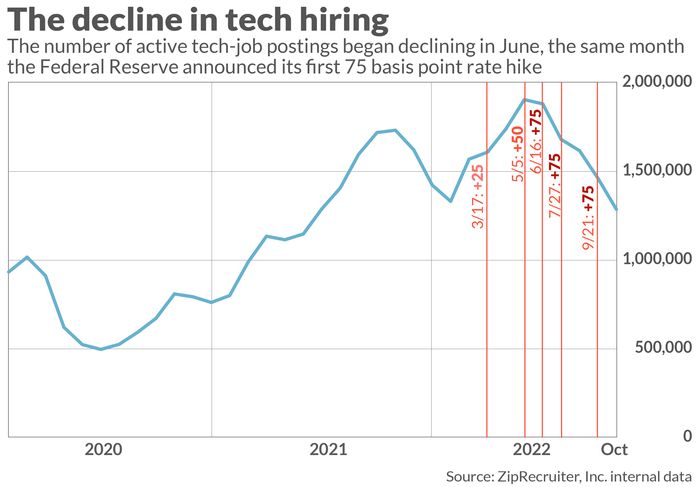
https://www.marketwatch.com/story/tech-hiring-is-slowing-down-this-chart-explains-how-and-why-11669057738?mod=home-page
7. $8 Trillion…1/2 of Chinese GDP Collateralized by Land Values
The property downturn is a particular problem for China as local government debt – of which there is an estimated $8 trillion of outstanding, half of China’s GDP – is often collateralized by land values. Falling land values increase the chance of collateral calls, leading to the distressed sale of other assets, adding to deflationary dynamic.
China saw the largest rise in private debt since 2010 of any country in the world, with the private-debt-to-GDP ratio rising a dizzying 90 percentage points.
That has led to China’s debt service ratio, the ratio of its debt service repayments to private disposable income, to rise above 20%.
The BIS notes that DSRs of 20%-25% have preceded financial crises in other countries. Hong Kong’s DSR is even worse at over 30%.
One increasingly likely lever China will pull (and has been pulling) to ease the debt problem is allowing the yuan to weaken, and perhaps eventually dropping the fixed-rate exchange system altogether. Property easing measures and an eventual exit from Covid restrictions will help, but the debt problem is not going away.

https://www.zerohedge.com/markets/end-zero-covid-will-not-cure-chinas-deep-set-debt-problem
8. We have Showed this Chart Before but Now 3 Months in a Row of Falling Rents….Another Lagged Inflation Number
Housing costs 40% of CPI
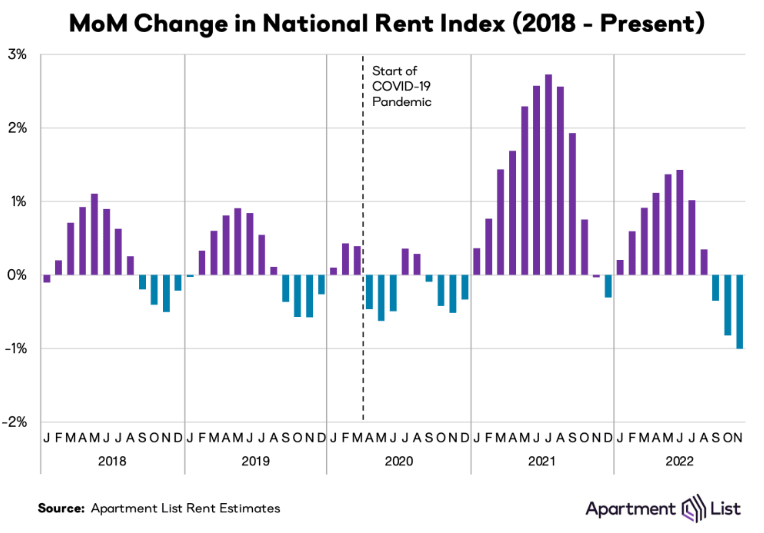
https://www.apartmentlist.com/research/national-rent-data
9. The Pentagon fails its fifth audit in a row If the Defense Department can’t get its books straight, how can it be trusted with a budget of more than $800 billion per year?
Written byConnor Echols
Last week, the Department of Defense revealed that it had failed its fifth consecutive audit.
“I would not say that we flunked,” said DoD Comptroller Mike McCord, although his office did note that the Pentagon only managed to account for 39 percent of its $3.5 trillion in assets. “The process is important for us to do, and it is making us get better. It is not making us get better as fast as we want.”
The news came as no surprise to Pentagon watchers. After all, the U.S. military has the distinction of being the only U.S. government agency to have never passed a comprehensive audit.
But what did raise some eyebrows was the fact that DoD made almost no progress in this year’s bookkeeping: Of the 27 areas investigated, only seven earned a clean bill of financial health, which McCord described as “basically the same picture as last year.”
Given this accounting disaster, it should come as no surprise that the Pentagon has a habit of bad financial math. This is especially true when it comes to estimating the cost of weapons programs.
The Pentagon’s most famous recent boondoggle is the F-35 program, which has gone over its original budget by $165 billion to date. But examples of overruns abound: As Sens. Jim Inhofe (R-Okla.) and Jack Reed (D-RI) wrote in 2020, the lead vessel for every one of the Navy’s last eight combatant ships came in at least 10 percent over budget, leading to more than $8 billion in additional costs.
And another major overrun is poised to happen soon, according to a recent report from the Congressional Budget Office.
The Navy plans to expand its ship production in an effort to maintain an edge over China, with a particular focus on a new attack submarine and destroyer ship. The Pentagon has proposed three versions of this plan at an average cost of $27 billion per year between 2023 and 2052, a 10 percent jump from current annual shipbuilding costs.
But the CBO says this is a big underestimate. The independent agency’s math says the average annual cost of this shipbuilding initiative will be over $31 billion, meaning that the Navy is underestimating costs by $120 billion over the program’s life.
As Mark Thompson of the Project on Government Oversight recently noted, these overruns “shouldn’t come as a shock” to anyone who has paid attention to DoD acquisitions in recent years. “But it does suggest a continuing, and stunning, inability by the Navy to get its ducks, and dollars, in a row,” Thompson wrote.
So will the Pentagon manage to get its financial house in order any time soon? It’s possible, if a bit unlikely.
Despite the long odds, a bipartisan group of lawmakers led by Sen. Bernie Sanders (I-Vt.) proposed a bill last year that could help make that happen. The legislation would cut one percent off the top of the budget of any part of the Pentagon that fails an audit. That means that, if the proposal had already passed, 20 of the agency’s 27 auditing units would face a budget cut this year.
Unfortunately, momentum around that bill appears to have fizzled out, leaving the Pentagon’s accountants as the last line of defense. Per Comptroller McCord, the DoD hopes to finally pass an audit by 2027, a mere 14 years after every other agency in the U.S. government blew past that milestone. That may coincide with another historical moment, according to Andrew Lautz of the National Taxpayers Union.
“[W]e could reach a $1 trillion defense budget five years sooner [than the CBO estimates], in 2027,” Lautz wrote.
Responsible Statecraft’s independent, authentic journalism promotes democratic accountability and poses a transpartisan challenge to militaristic foreign policy! Responsible Statecraft is the online magazine of the Quincy Institute(QI). Please help us lift up new voices of realism and military restraint with your 100% tax-deductible donation to the Quincy Institute in support of Responsible Statecraft. Donate here.
10. Cognitive Strategies of Elite Soccer Players and Athletes
Psychology Today Can time dilation explain soccer superstars Lionel Messi and Cristiano Ronaldo? Raj Persaud, M.D. and Peter Bruggen, M.D.
KEY POINTS
- Perceptual time can appear to slow down in some instances and may have practical benefits.
- Elite athletes deliberately train under more challenging conditions that they would normally endure.
- Physical strength may compete with superior mental processing to determine who wins in sporting competitions.
Soccer is the planet’s most popular sport (outside of the USA), and the FIFA World Cup is therefore perhaps the largest mega-event in sports, possibly even surpassing the Olympics in worldwide fan interest.

Cristiano Ronaldo and Lionel Messi
Source: Fanny Schertzer
Arguably the two greatest soccer players of all time, Cristiano Ronaldo of Portugal and Lionel Messi of Argentina, are both playing in the current FIFA World Cup tournament in Qatar, representing perhaps the last opportunity to witness such a unique spectacle.
Theories as to why some elite athletes become practically unbeatable, invoke not just physical strength but also neuroscience and psychology.
How to Freeze Time
A research paper entitled, “Can Lionel Messi’s Brain Slow Down Time Passing?” suggests that elite competitors become outstanding at anticipating their opponent’s next move, before they make it.
The authors argue that the key reason why the Argentinian soccer star is difficult to stop is that he makes sure his adversaries don’t have enough time. This is because, so the argument goes, in Messi’s mind time passes more slowly.
These authors contend that if perceptual time for an elite athlete slows down, this enables them to see more of what is happening on the field of play. Paradoxically, if their sensory systems work faster, then more computations-per-second deliver a “wider bandwidth” for grasping events on the pitch.
The authors of a study entitled “Psychological and Neural Mechanisms of Subjective Time Dilation”, show how for any set period of time, certain events can be experienced as longer than others.
For example, they suggest you try this for yourself: Take a quick glance at the second hand of a clock or watch. Immediately, the tick will pause momentarily, and appear to be longer than the subsequent ticks. Yet, they all last exactly one second.
Suppose for athletes like Lionel Messi, on the field of play, they see the equivalent of the second hand as always running slower than their opponents?
Another study entitled, “Mastery in Goal Scoring, T-Pattern Detection, and Polar Coordinate Analysis of Motor Skills Used by Lionel Messi and Cristiano Ronaldo,” argues that it is the dynamic nature of superior skill that distinguishes the elite athlete; the player needs to perform the right action at the right time.
article continues after advertisement
Goal-scoring sequences were analyzed from the moment the player receives the last pass to the moment he scores a goal, and the conclusion of this investigation was that both players, Messi and Ronaldo, better anticipate the actions of their opponents, resulting in higher success in attacking.
In a paper entitled, “The Discovery of Slowness: Time to Deconstruct Gretzky’s and Messi’s Predictive Brains,” the Argentinian example, it is suggested, was preceded by the astounding case of ice-hockey star Wayne Gretzky.
Between 1979 and 1999, the Canadian ice hockey player broke numerous records. As he was not a particularly impressive physical specimen, when trying to explain how he differed from other players, it would appear that during a match, time could be said to “freeze” for him.
According to Gretzky, he considered ice hockey as a rather slow game. By weaving together his reading of immediate sporting predicaments, Gretzky often predicted what would happen next.
Being able to predict what is going to occur is not just useful for elite athletes, it is of everyday significance in our daily lives as well.
The authors of a study entitled, “Why am I Always Late? Modelling the Cognitive Mechanisms Underlying Anticipatory Timing Under Uncertainty,” give an example: imagine trying to swat a fly? This requires being able to predict precisely where the insect will be and when, given the fly usually moves faster than you can. In life, you are not just spontaneously reacting to some event, but rather you are frequently engaging in anticipatory timing, calibrating your actions for a scenario you figure is coming.
A lot of life is a kind of choreography, where if you are not good at anticipating the move of your protagonist, you are going to collide.
In their experiment, subjects viewed the motion of a ball and then had to predict where it would be when it was occluded from view for a while.
The authors found there was a link between people’s ability to correctly anticipate the ball, and some other key aspects of their lives, linked to time judgments, including their tendency to be late, the ability to plan ahead, starting and completing tasks on time.
article continues after advertisement
The results of this experiment suggested that generally becoming more aware of the passage of time, even as simple as glancing at a clock more often, could help improve anticipation, and this could have knock-on benefits to us in a wide variety of different areas of life, particularly if we have generally a problem with timing.
But what if you want to get as good as Lionel Messi with your visual reaction time? Can you make time slow down with training?
A study entitled “Sports Vision Training: A Review of the State-Of-The-Art in Digital Training Techniques” points out there is a long history of athletes purposefully practicing under tougher conditions than they would find in an actual match, in order to develop.
From the use of strobe lights in otherwise dark settings, to digitally controlled eyewear that can be used in natural practice situations, by intermittently disrupting vision, individuals are only allowed to see brief snapshots of their environment. They therefore train under tougher conditions, which include a disrupted visual experience.
The stroboscopic effect, the theory goes, produces better visual skills when athletes return to normal conditions.
The Takeaway
The recurring pattern in the lesson of how to become an elite athlete is to create tougher conditions than normal, and the body and brain grow and adapt in response to the challenge, becoming stronger and fitter.
Lionel Messi was diagnosed with a growth hormone deficiency as a child, and at five foot seven inches he remains one of the shortest players in the FIFA World Championship.
According to the sportstar.thehindu.com website, if we take a continental average, the European dominance in average height across teams at the current FIFA world cup is massive. The average height of European squads in Qatar is 183 cm. This drops to 180.9 cm for South American teams.
article continues after advertisement
The shortest squads in terms of average height will be from North America, with their average heights touching only 180.7.
But it appears that even in sport when physical reality like height can be very important, it is possible for psychological mechanisms to compensate.
Maybe time slows down for Lionel Messi because this is how he adapted over many years to compensate for his body being shorter, compared to all the other kids, who may now be taller.
Faster mental speed, for some, could be more than a match for slower physical growth.